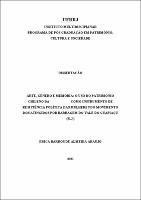Por favor, use este identificador para citar o enlazar este ítem:
http://rima110.im.ufrrj.br:8080/jspui/handle/20.500.14407/15657| metadata.dc.type: | Dissertação |
| Título : | Arte, gênero e memória: o uso do patrimônio chileno da arpilleria como instrumento de resistência política pelas mulheres do Movimento dos Atingidos por Barragem do Vale do Guapiaçu (RJ) |
| Otros títulos : | Art, gender, and memory: the use of the Chilean arpilleria heritage as an instrument of political resistance by the women of the Guapiaçu Valley Dam Affected Movement (RJ) |
| metadata.dc.creator: | Araújo, Erica Barros de Almeida |
| metadata.dc.contributor.advisor1: | Lazzari, Alexandre |
| metadata.dc.contributor.referee1: | Lazzari, Alexandre |
| metadata.dc.contributor.referee2: | Angelo, Elis Regina Barbosa |
| metadata.dc.contributor.referee3: | Valle, Arthur Gomes |
| metadata.dc.contributor.referee4: | Reznik, Luis |
| metadata.dc.description.resumo: | A proposta dessa dissertação consiste em investigar o uso do patrimônio chileno da arpilleria como instrumento de resistência política pelas mulheres que integram o Movimento dos (as) Atingidos (as) por Barragem (MAB) de Cachoeiras de Macacu, cidade que compõe a região metropolitana do Rio de Janeiro. Como patrimônio cultural chileno, a técnica da arpilleria foi ressignificada pelas mulheres brasileiras no que se refere aos materiais utilizados e recontextualizado segundo suas demandas relacionadas à questão dos impactos causados pela implantação da barragem do COMPERJ no município. O presente trabalho tem por base a memória coletiva das agricultoras do MAB que são expressas no objeto da arpillera e é subjacente à sua técnica. O saber-fazer que permeia a tapeçaria guarda através da técnica camadas de memórias inscritas no corpo do artesão que são expressas através do movimento de suas mãos na confecção de objetos que antes de remeterem ao utilitário, produzem linguagens que revelam uma dimensão simbólica informando acerca do tempo e as condições nas quais foram produzidos. Entre os eixos norteadores para a análise do uso da arpilleria pelas mulheres do MAB estão: a verificação do lugar ocupado pelas artes têxteis e pelas mulheres na arte contemporânea. Assim como, as estratégias contra hegemônicas vinculadas aos conceitos de desenvolvimento sustentável, ecofeminismo, agroecologia e soberania alimentar defendidos pela Via Campesina e a ONU como alternativas de resistência ao desenvolvimentismo que legitimou a implementação de barragens e seus impactos ambientais e sociais sobre as populações rurais, e as relações de poder implicadas no binômio capitalismo/patriarcado que permeiam as relações de classe e, principalmente, de gênero no mundo rural. |
| Resumen : | The purpose of this of dissertation is to investigate the use of the Chilean heritage of the arpilleria as an instrument of political resistance by woman who are part of the Movement of People Affected by the Dam of Cachoeiras de Macacu, city that makes up the region of Rio de Janeiro. As a Chilean cultural heritage, the arpillera technique was signified by Brazilian woman with regard to the materials used and recontextualized according to their demands related to the issue of the impacts caused by implementation of the COMPERJ DAM in the municipality. The present work is based on the collective memory of the MAB female farmers who are expressed in the arpillera and is underlying their technique. The know-how that permeates the tapestry keeps, through the technique, layers of memory inscribed on the body of the artisan that are expressed through the movements of his hands in the making of objects the before referring to the utility, they produce languages that reveal a symbolic dimension informing about the time and the conditions in which they were produced. Among the guiding axes for the analysis of the use of arpilleria by the women who produce them in contemporary art and the strategies against hegemony linked to the concepts of sustainable development, ecofeminism, agroecology and food sovereignty defended by Via Campesina and ONU as alternatives of resistance to developmentism that legitimized the implementation of dams and their environmental impacts and social effects on rural populations, as well as power relations implied in the binomial capitalism/patriarchy that permeate class and, mainly, gender relations in the rural world. |
| Palabras clave : | Identidade de gênero Patrimônio cultural chileno Arte têxtil Atingidas por barragens Desenvolvimento sustentável Ecofeminismo Agroecologia Arpilleria Cachoeiras de Macacu Gender Identity Chilean Cultural Heritage Textile Art Affected by Dams Sustainable Development Ecofeminism Agroecology |
| metadata.dc.subject.cnpq: | Sociologia Antropologia Artes |
| metadata.dc.language: | por |
| metadata.dc.publisher.country: | Brasil |
| Editorial : | Universidade Federal Rural do Rio de Janeiro |
| metadata.dc.publisher.initials: | UFRRJ |
| metadata.dc.publisher.department: | Instituto Multidisciplinar de Nova Iguaçu |
| metadata.dc.publisher.program: | Programa de Pós-Graduação em Patrimônio, Cultura e Sociedade |
| Citación : | ARAÚJO, Erica Barros de Almeida. Arte, gênero e memória: o uso do patrimônio chileno da arpilleria como instrumento de resistência política pelas mulheres do Movimento dos Atingidos por Barragem do Vale do Guapiaçu (R.J.). 2021. 193 f. Dissertação (Mestrado em Patrimônio Cultura e Sociedade) - Instituto Multidisciplinar de Nova Iguaçu, Universidade Federal Rural do Rio de Janeiro, Nova Iguaçu, RJ, 2021. |
| metadata.dc.rights: | Acesso Aberto |
| URI : | https://rima.ufrrj.br/jspui/handle/20.500.14407/15657 |
| Fecha de publicación : | 10-feb-2021 |
| Aparece en las colecciones: | Mestrado em Patrimônio, Cultura e Sociedade |
Se for cadastrado no RIMA, poderá receber informações por email.
Se ainda não tem uma conta, cadastre-se aqui!
Ficheros en este ítem:
| Fichero | Descripción | Tamaño | Formato | |
|---|---|---|---|---|
| 2021 - Erica Barros de Almeida Araujo.pdf | 7.56 MB | Adobe PDF |  Visualizar/Abrir |
Los ítems de DSpace están protegidos por copyright, con todos los derechos reservados, a menos que se indique lo contrario.

